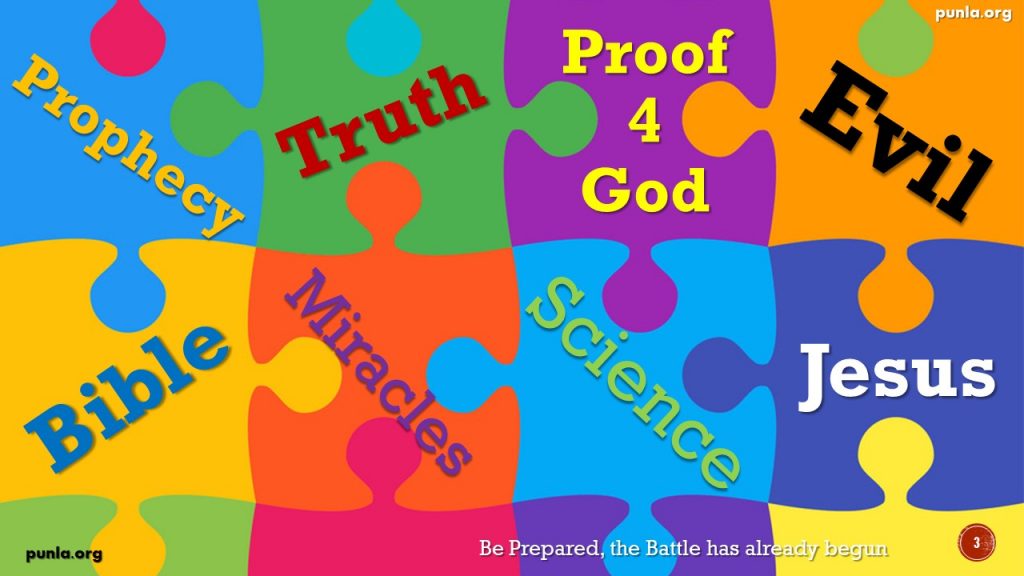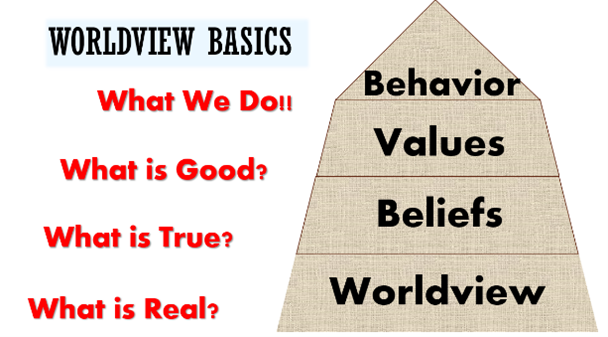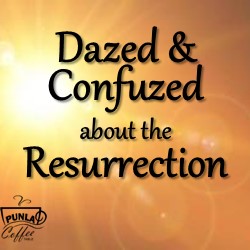Looking at our puzzle again. Each piece is part of our Christian Worldview. Today we are going to put all the puzzle pieces together.
Remember worldview.


I used the old fable of the 6 blind men and elephant to demonstrate that without a complete picture of reality you can only describe what you know. You might be partially right but in the end you are completely wrong. Because there is only one truth.
We talked about how our worldview is the foundation on which our beliefs, values and ultimately behaviors are built. If our worldview is not clearly defined then all aspects of our life will be in flux.


We talked about the big questions that formulate everyone’s worldviews. Whether they want to or not everyone answers these questions.
I introduced you to ARROW as a way to test and evaluate our worldviews, opinions as well as Bible interpretations.
I color coded ARROW for you so you can see how it works more clearly

Application is Red. This is livability. Blue is relevance or is the view essential to living. Green is revelation, what is the source of the idea. Yellow is opinion or bias. It’s all the assumptions we make in order to believe something. and Orange is witness which is the observations and evidences for and against our views.
I gave you a scorecard for the six worldviews we tested. I expanded it a little so you can see that many of the worldviews don’t stand up to the ARROW test in several categories. Sometimes all of them. An example is the Nihilist who says reality is nothing. They can’t know that!
They can’t live that way. This opinion affects how they live negatively. They say they don’t trust any sources but they still seem to believe this one. I can go on and on. The way they live and think is simply inconsistent with what they say they claim in every reasonable and rational and logical way.

Next we addressed the issue of truth, goodness and beauty which is the foundation for our values and ethics. It is also excellent proof that there is a God.
We talked about the Law of Non-Contradiction and practiced it a little bit.
This is the tactic of applying the claim to itself to expose what is true and what is false.
Here is the list of common objections to truth that we used this technique to address.
There is no truth!
Is that true
It’s true for you… but not for me!
Is it true for everybody
You can’t know truth!
How do you know that is true
No one has the truth!
is that true
All Truth is relative!
That sounds absolute
You ought not judge!
Isn’t that a judgment

Whatever claim they make our first response should be to test it with a question like “what do you mean by that.” A probing question to gather information and test for fallacies.
Here is a claim you have to think about before responding to.
Are you saying that if I don’t believe the way you do, I’m sent to hell!
How do we answer the objection
- What do you think sends you to hell?
- What do you believe?
- I don’t understand your question.
- Do you believe in heaven & hell?
or what about a 2 step process
#1 Do believe people should be punished for bad things?
#2 Have you ever done a bad thing?
Obviously a honest person will say yes to both questions, and you can respond, “you and me both.” Now we have common ground to build our conversation around. We both deserve punishment, so how do you think God should punish us?
What is the solution?
Identify the problem, then identify a solution to that problem. This leads us back to the need for a Savior.
We asked the big question, “is there a God?”
Well yes, but we made our case brick by brick using, the cumulative case approach for God and specifically the God of the Bible, Jesus.

We started with the Evidence for God which includes,
1.Beginning (Cosmological Argument)
2.Design (Teleological Argument) at all levels of creation including Universe, Galaxy, Solar System, Earth, Life and Sub-Atomics
3.Morality (Moral Argument)
4.Being (Ontological Argument)
5.Truth (Basis – Objective Truth)
6.Data (Information Argument)
7.Aesthetics (Beauty)
8.Consciousness (Mind)
9.Mathematics Principles
10.Logic & Reason
11.Science (Laws & Constants)
12.Purpose & Meaning
13.Jesus (Historicity & Resurrection)
14.Miracles (Supernatural)
15.Spiritual Encounters (Metaphysical)
16.Near Death Experiences
And this list can go on and on. We saw that the beginning argument or the cosmological argument points to a starting point most call the big bang. But a big bang requires a big banger. Aristotle’s unmoved mover, or the 1st cause, cause. We would simply say, God.
We studied the moral argument. There must be a basis for good and bad or right and wrong.
Atheists like Sam Harris say, things like human flourishing determines right and wrong. I actually partially agree with Sam Harris. The purpose of moral and ethics is to allow for human flourishing, but who decides what human flourishing looks like? We know from history the horrific things that have been done in the name of human flourishing. It only works if the one who determines right and wrong is the creator God. Only God know what is truly best for human flourishing.
We went through the levels of the Design argument or Teleological argument. We looked at levels from the universe or cosmos, the galactic level, the solar system levels, down to our planetary level and event life itself. We also looked even smaller to the subatomic level. At every level of existence we find complexity, diversity, and design which all point to a designer. Clear evidence of God.
Using only three of these evidences, the Cosmological, teleological and moral arguments, we found overwhelming cumulative case evidence for God. The beginning of everything requires an immaterial, timeless, and space-less first cause cause which was extremely powerful to make everything from nothing.
The design of the universe requires a designer who is extremely intelligent and sustains creation for His purpose.
Morals and ethics require a standard which is absolutely morally perfect and personal.
The fingerprints of Almighty God are all over His creation.

Next we took a deep look at our problem with evil.
We saw that evil is the absence of goodness. More specifically God’s goodness. Evil is an imperfection which comes from human selfishness and lack of understanding of God’s bigger and better plan.
We too often forget what Jesus experienced and did for us. Why do we the servants think we are better than our King. Troubles are God’s way for getting our attention. What we see as bad or evil, is sometimes what is necessary for us and others to search for God.
Evil is the absence of goodness;
There is no evil without goodness;
Therefore, the only source of goodness is God.
We asked the hard questions about evil and discovered that evil proves God exists
Whether we like it or not, God has a purpose in what we call evil. I don’t have to like it or understand. God has a remedy for the evil in this world. It is Jesus and His church. We are meant to be part of that remedy. We can’t run and hide from it.
We heard wisdom from monk Jacques-Marie-Louis Monsabre who said, “If God would concede me His omnipotence for 24 hours, you would see how many changes I would make in the world. But if He gave me His wisdom too, I would leave things as they are.”
What can I possibly add to that. It is so true.
C.S. Lewis told us in his book the Problem of Pain, “God whispers to us in our pleasure, speaks in our conscience, but shouts in our pains; it is His megaphone to rouse a deaf world.”
Pain is worth it for God. My pain, your pain, the pain of others is worth it if it points us to God.
This is the end of How to Defend your Faith Session 12: the Plan (Part 2 of 4)


